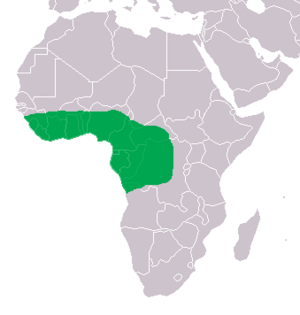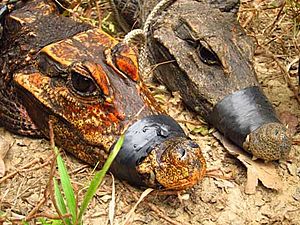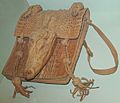Dwarf crocodile facts for kids
Quick facts for kids Dwarf crocodile |
|
|---|---|
 |
|
| Conservation status | |
| Scientific classification | |
 |
|
| Range of the dwarf crocodile in green |
The dwarf crocodile (Osteolaemus tetraspis) is also known as the African dwarf crocodile. People sometimes call it the broad-snouted crocodile or bony crocodile. It is the smallest living type of crocodile found in Africa.
Contents
What's in a Name?
The scientific name for the dwarf crocodile is Osteolaemus tetraspis. Let's break down what that means!
Osteolaemus: Bony Throat
The first part, Osteolaemus, comes from ancient Greek words. "Osteon" means bone and "laimos" means throat. This name was chosen because these crocodiles have special bony plates. These plates, called osteoderms, are found under their skin on their neck and belly.
Tetraspis: Four Shields
The second part of the name, tetraspis, also comes from ancient Greek. "Tetra" means four and "aspis" means shield. This refers to the four large, shield-like scales on the back of the crocodile's neck.
Dwarf Crocodile Features


Dwarf crocodiles are quite small for crocodiles. They usually grow to be about 1.5 meters (5 feet) long. The longest one ever recorded was about 1.9 meters (6.2 feet).
Size and Weight
Adult dwarf crocodiles typically weigh between 18 and 32 kilograms (40 to 70 pounds). The biggest females can weigh up to 40 kg (88 lb). The largest males can reach 80 kg (176 lb). This makes them the smallest living crocodile species.
However, there's an even smaller animal in the crocodile family! The Cuvier's dwarf caiman is a bit smaller. It only grows to about 1.7 meters (5.6 feet).
Appearance
Adult dwarf crocodiles are dark in color on their backs and sides. Their bellies are yellowish with black spots. Some dwarf crocodiles live in the Abanda Caves in Gabon. These cave dwellers can have orange patches on their skin. Scientists think this might be from bat droppings that change their skin color.
Young dwarf crocodiles look a bit different. They have lighter brown stripes on their bodies and tails. They also have yellow patterns on their heads.
Body Armor
Because they are small, dwarf crocodiles are more easily hunted by other animals. To protect themselves, they have very strong armor. Their neck, back, and tail are heavily armored. They also have those special bony plates, or osteoderms, on their belly and under their neck.
Snout and Teeth
The dwarf crocodile has a short, blunt snout. It's about as wide as it is long. This type of snout is good for their lifestyle. They have a specific number of teeth in their jaws.
Where They Live and Their Home
Dwarf crocodiles live in the warm, tropical parts of West and Central Africa. Their home range stretches from Senegal in the west to Uganda in the east. They can also be found as far south as Angola.
Habitat Preferences
These crocodiles prefer to live in streams, small rivers, swamps, and pools. They also live in mangrove areas. They usually avoid the main parts of large rivers. Most dwarf crocodiles live in forested areas. However, they can also be found in more open places if there is enough shade from trees.
Day and Night Habits
Unlike many other crocodiles, dwarf crocodiles do not often lie in the sun. They usually stay hidden during the day. At night, they might travel some distance away from the water on land. There are even reports of dwarf crocodiles living in isolated pools in grassy plains. Some dwarf crocodiles live permanently in caves in western Gabon. These cave crocodiles are a special group with unique genes.
Dwarf Crocodile Life and Habits
The dwarf crocodile is a shy reptile. It is mostly active at night, which means it is nocturnal. During the day, it hides in pools or burrows. Sometimes, it might be active during the day too.
What They Eat
Dwarf crocodiles are not picky eaters. They are generalist predators. This means they eat many different small animals. Their diet includes fish, crabs, frogs, snails, insects, lizards, water birds, bats, and small mammals like shrews.
In some areas, fish are their main food. In other places, snails and crabs are more common. Their diet can change with the seasons. For example, they might eat more fish in the wet season. Then they switch to crustaceans (like crabs) in the dry season when fish are harder to find. They can also go a long time without food.
Their Hiding Places
Dwarf crocodiles are solitary animals. They dig burrows to hide and rest during the day. These burrows sometimes have an entrance that is underwater. If they can't dig a burrow, they might hide among tree roots that hang over the water.
Reproduction and Life Cycle
Dwarf crocodiles only spend a lot of time together during the breeding season. This usually happens at the start of the wet season, around May and June.
Nests and Eggs
Female dwarf crocodiles build their nests near the water. The nest is a mound made of wet, rotting plants. This decaying plant material creates heat, which helps to warm the eggs. They lay a small number of eggs, usually around 10. Sometimes, they can lay up to 20 eggs. The eggs take about 85 to 105 days to hatch.
Hatchlings and Protection
When the baby crocodiles hatch, they are about 28 centimeters (11 inches) long. The mother crocodile guards the nest while the eggs are incubating. After the eggs hatch, she continues to watch over her young for some time. This is important because many animals like birds, fish, mammals, and even other crocodiles might try to eat the young ones.
Protecting Dwarf Crocodiles
The dwarf crocodile is considered a vulnerable animal by the IUCN. This means its population is decreasing and it could become endangered. It is also listed on Appendix I of CITES. This means it is highly protected and international trade of these animals is usually not allowed.
Threats to Their Survival
Scientists don't know as much about dwarf crocodiles as they do about other crocodile species. This makes it harder to know how well their populations are doing. They face threats from human activities. People sometimes hunt them for bushmeat (meat from wild animals). Their homes are also being destroyed due to deforestation, which is when forests are cut down.
While they are widespread, their numbers are declining in some areas. In places like Gambia and Liberia, their populations have seriously dropped. However, in other regions, their numbers are still healthy. Dwarf crocodiles live in several protected areas, which helps them survive.
Other Uses and Zoos
Some of their skins are used locally to make leather products. However, the leather is not very good quality, so there isn't a big demand for it. They are sometimes hunted for food and sold as bushmeat.
Dwarf crocodiles are also kept and bred in zoos around the world. This helps with conservation efforts and allows people to learn more about them.
Images for kids
-
Juvenile in Ghana
-
Dwarf crocodile at North Carolina Zoo
-
A handbag made from West African dwarf crocodile leather exhibited at the Natural History Museum, London. Hunting for leather is also a main threat to the dwarf crocodile.
See also
 In Spanish: Cocodrilo enano para niños
In Spanish: Cocodrilo enano para niños





